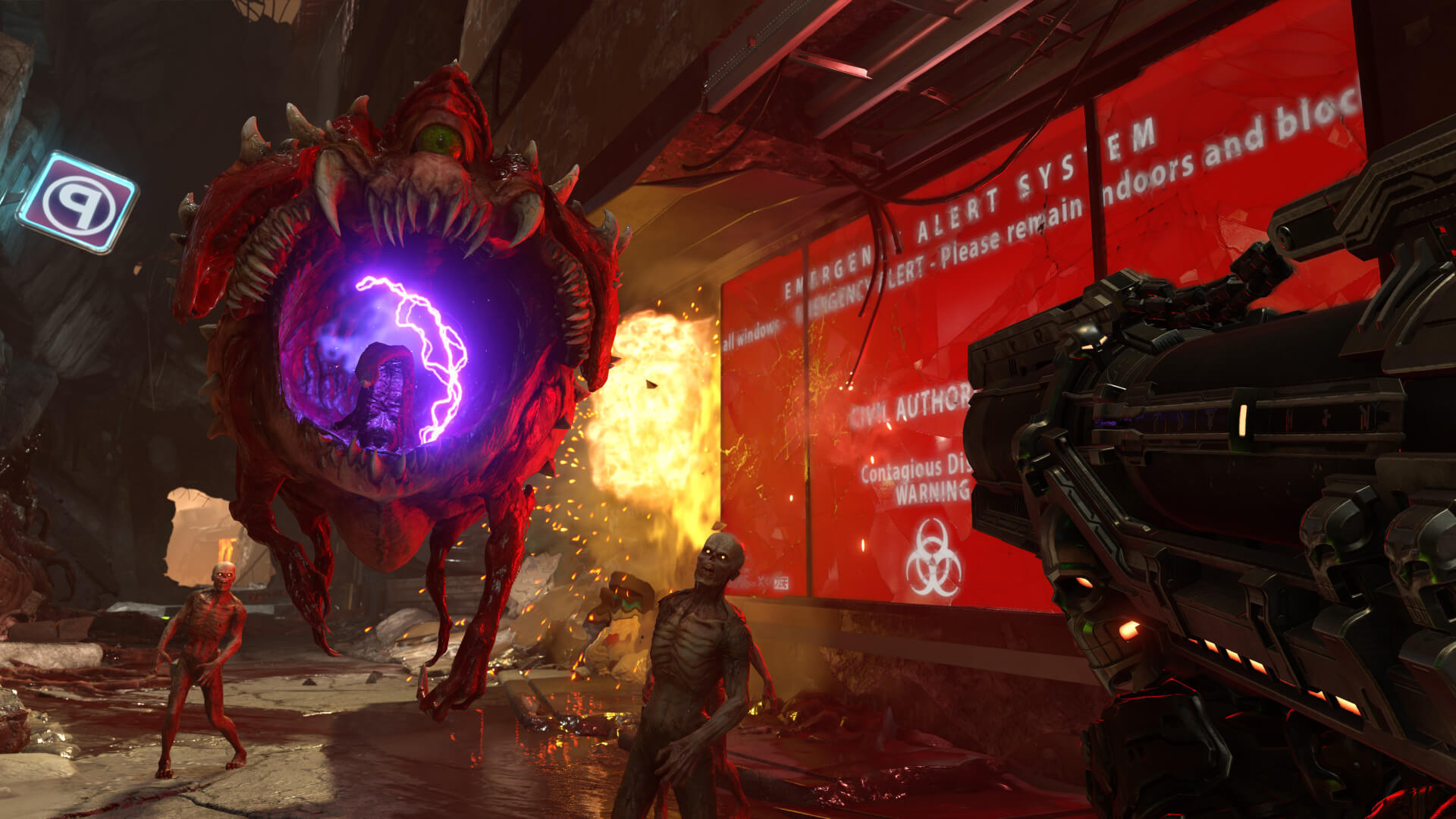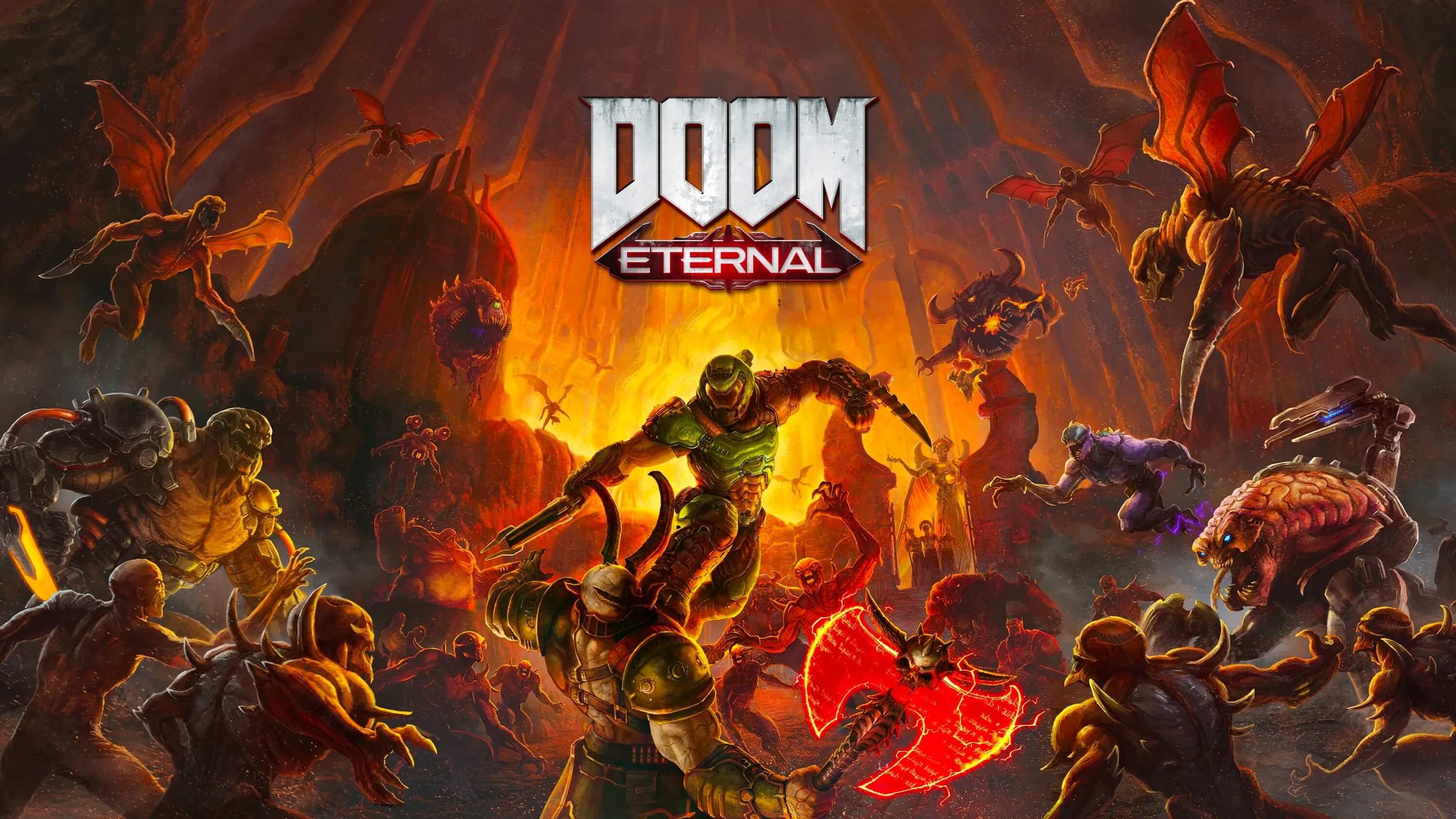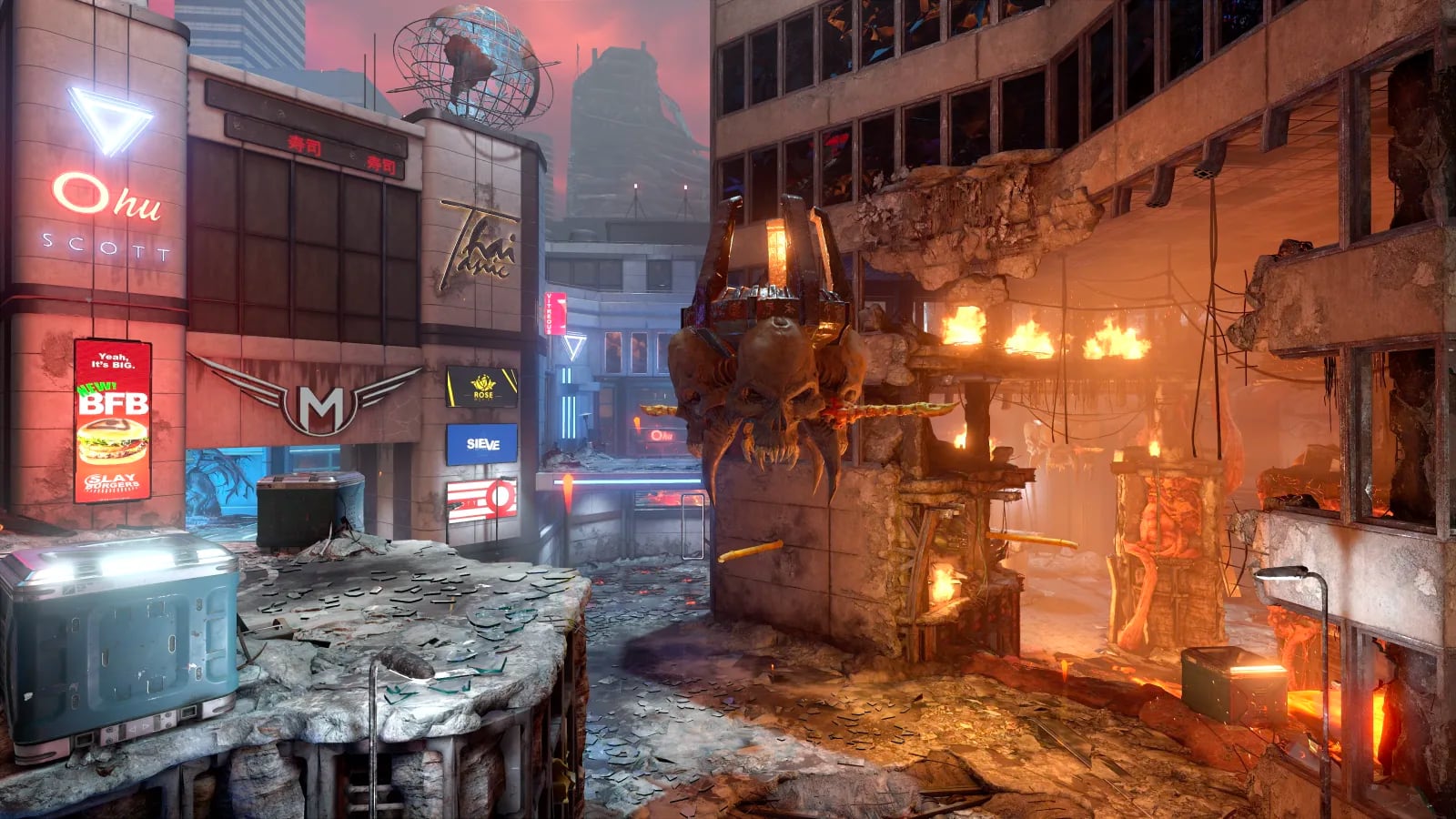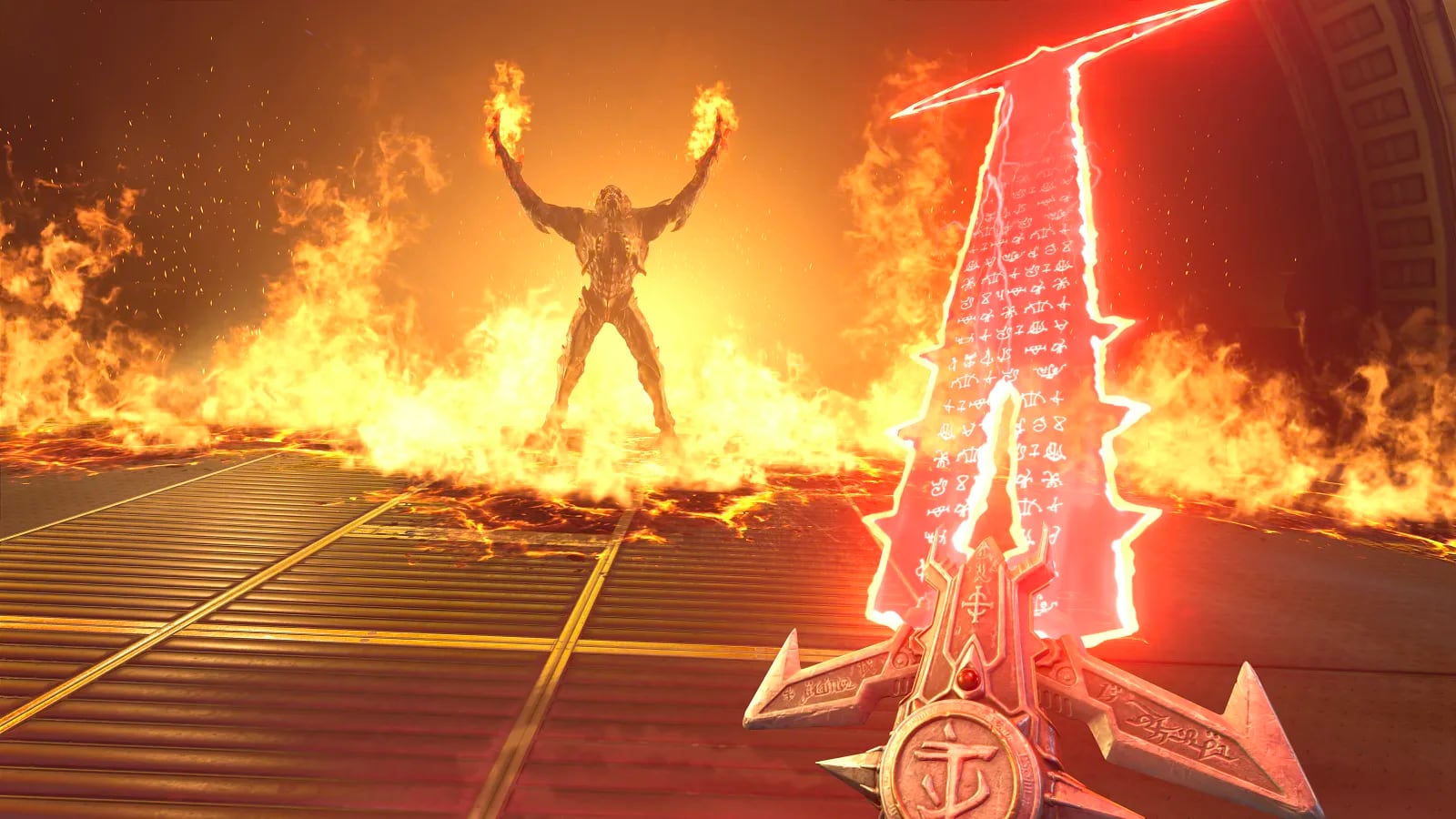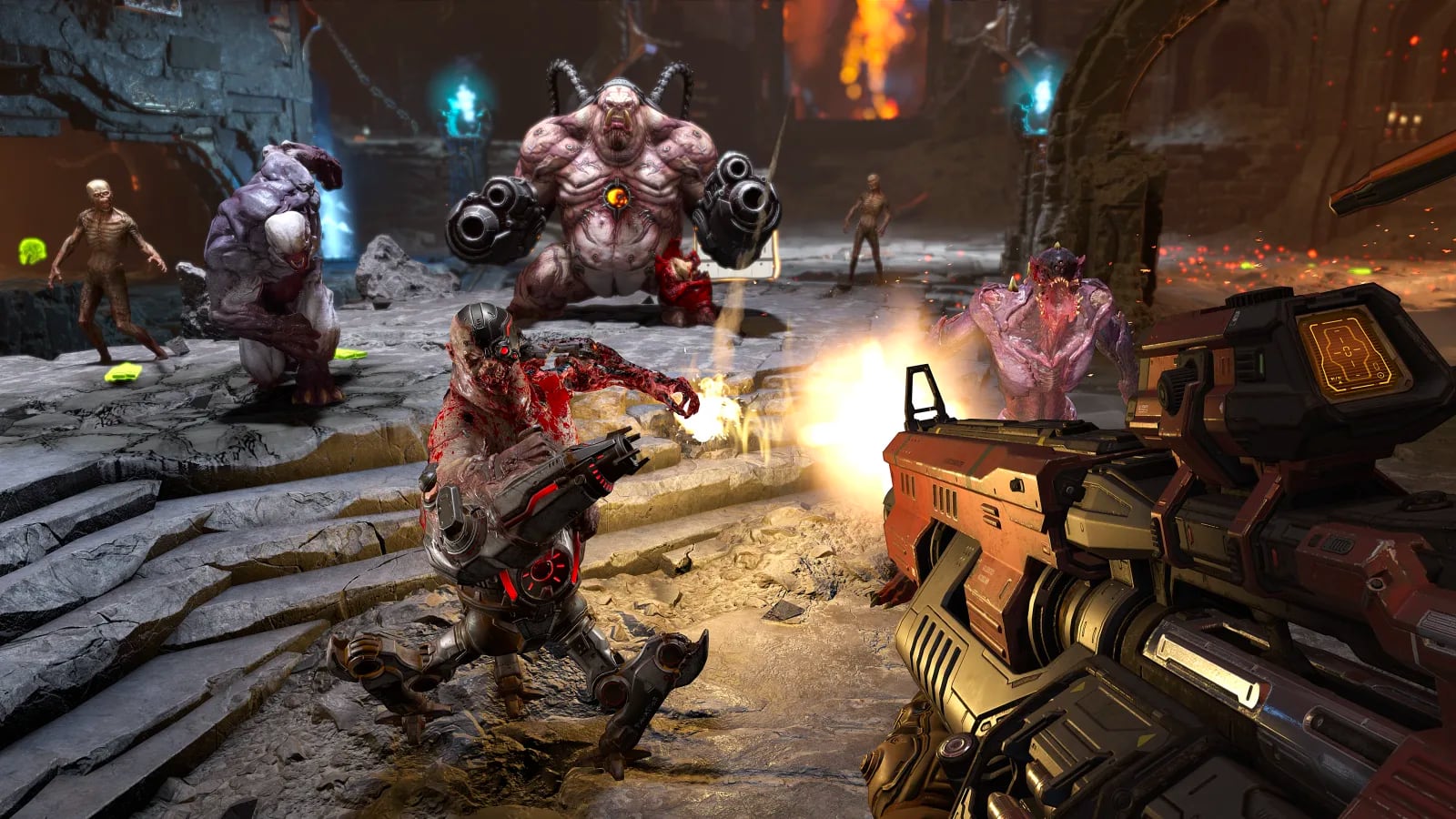Doom Eternal is the series' latest demon-killing romp, bringing more weapon variety, more movement possibilities, a plethora of new demons to face off against – some pulled from the original Doom games, some entirely fresh – and exciting new environments to explore. Today we're taking 25 graphics cards to see how they perform in Doom Eternal using the latest optimized GPU drivers.
We may be a little late to the party on this one, but there's a good reason. Although it was possible to gain early access to the game and we could have provided an in-depth benchmark analysis ahead of release, we would have wasted our time and yours by doing so. Nvidia didn't release GeForce game ready drivers with day-one optimizations for Doom Eternal until the actual launch.
The current GeForce 442.74 driver offers big performance gains for GeForce owners. Some early benchmarks showed the 5700 XT beating even the RTX 2080 Super, but as it turns out that information is no longer accurate. AMD also released a new Adrenalin driver that boosts performance in Doom Eternal by up to 5%, though that's when using the Ultra Nightmare settings.
Doom Eternal was built on top of id Tech 7, id Software's latest iteration of their impressive in-house game engine. The id Tech 7 engine is exclusively Vulkan-based, meaning OpenGL has been dropped which has saved developers time to focus entirely on this API. The new engine features ten times the geometric detail of its predecessor (used in 2016 Doom and Wolfenstein II: The New Colossus) along with higher texture fidelity. Improving immersion is a new system called "Destructible Demons" that as the name suggests, sees enemies' bodies deteriorated as they take damage. The game features proper HDR support, and global illumination capabilities have been enhanced.
The game does look amazing and appears to run very well on modern hardware. There's a good degree of customization along with half a dozen presets and for testing today we'll be using the third highest option labeled "Ultra," but with resolution scaling set to off. The reason we're using this preset is that the game imposes a VRAM restriction on cards without enough memory to run at the higher settings. For example, 6GB cards can't use the next higher preset 'Nightmare', at resolutions above 1080p. Ideally we want to provide apples-to-apples data, so you can see how much faster an RTX 2070 Super is compared to a GTX 1070, for example, and this is the best way to provide that information.
With the "Ultra" preset we can run up to 4K with 6GB cards. However, for 4GB and lower models, the ultra preset isn't an option as 5.2 GB is used at 1080p. You'll need to drop down to "High" for 4GB graphics cards. Just to be clear here, you cannot exceed the VRAM limits, so it's not possible to test a 4GB RX 570 with the Nightmare or Ultra Nightmare presets, without manually lowering certain settings such as textures to reduce VRAM consumption.
We'll provide some preset scaling results using the RTX 2080 Ti and Radeon VII, as both cards feature fat VRAM buffers. We'll also provide some results using the dynamic resolution scaling feature, though we won't be looking into visual quality comparisons.
For testing we've used an early section of the game, right after the first Hell Priest has been terminated we're having a 60 second pass, with all results based on a 3-run average. Testing took place on our usual GPU test rig which features a Core i9-9900K clocked at 5 GHz with 16GB of DDR4-3400 memory.
Update (3/25): After publishing this benchmark feature we detected some bugs with the game and AMD Radeon drivers that affected results. We have updated all data below to reflect those changes. While margins have not changed dramatically, for the sake of transparency and accuracy we conducted several more hours of tests and have updated all graphs accordingly.
Benchmarks
First up we have the 1080p results and as we found previously, pretty much any modern GPU, as long as it has at least 6GB of VRAM, can deliver playable performance at 1080p. Here we see the 8GB 5500 XT averaging 91fps, the same level of performance also seen from the RX 580 and 590. The RX 580 was a whopping 20% faster than the GTX 1060, averaging 91 fps and never dipping below 70 fps, so a nice smooth experience there.
The 5600 XT is a standout modern GPU in the ~$300 price range, pumping out over 100 fps at all times for 133 fps on average. That made it 7% faster than the RTX 2060 and it even managed to outplace Vega 64. Moreover, the RX 5700 was only a further 8% faster, though that's a fairly typical margin and it meant the RX 5700 still falls short of the RTX 2060 Super in our testing.
We also included the GTX 980 Ti, though it would also seem as though Nvidia's yet to optimize for Maxwell based GPUs as the GTX 1660 Super smashed the GTX 980 Ti out of the park, not something you'd expect to see.
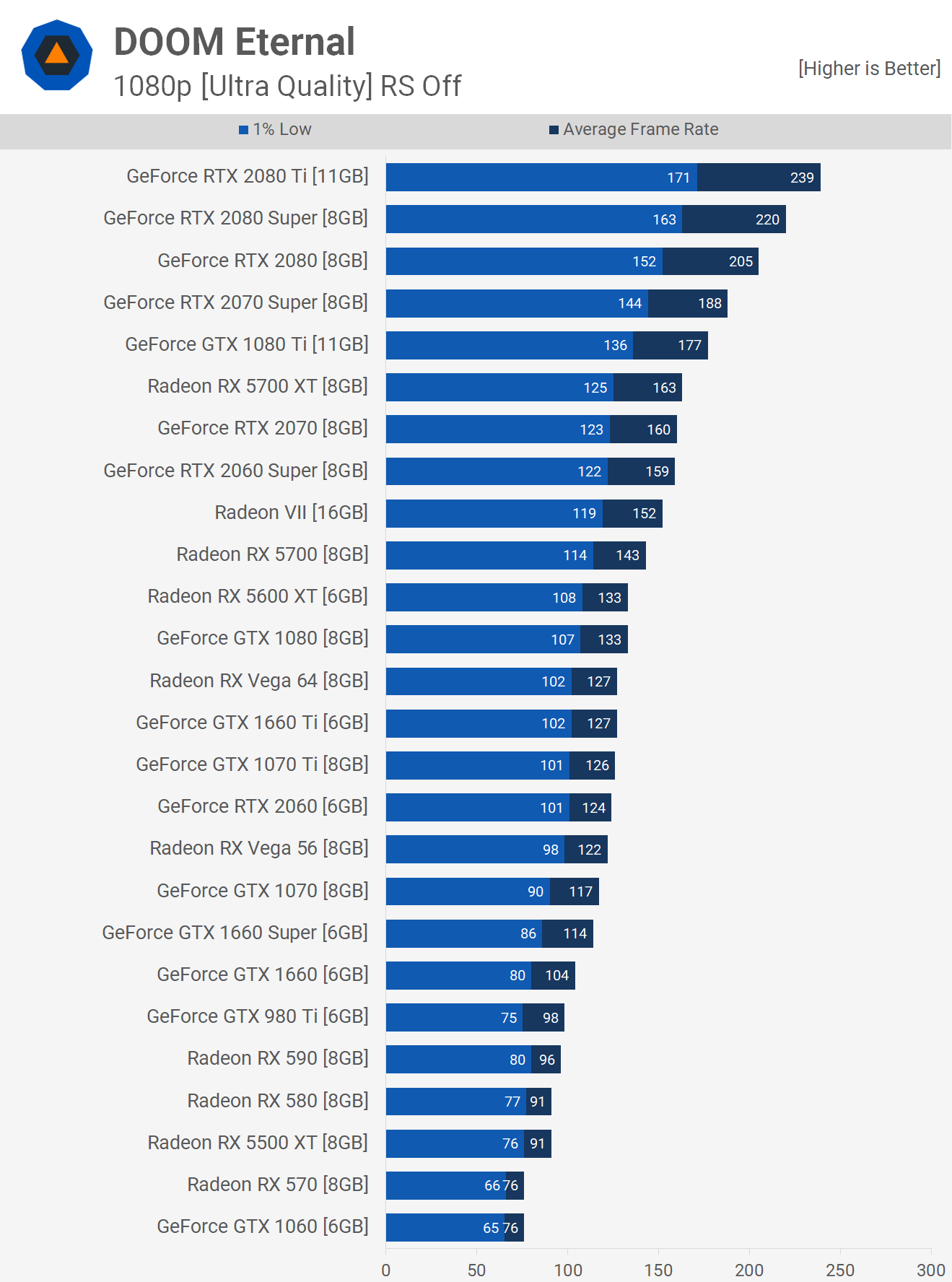
The Radeon 5700 XT is impressive, averaging 163 fps, making it a few fps faster than the RTX 2060 Super. That said the RTX 2070 Super was 15% faster, though keep in mind it does cost about 25% more. (For those wondering, before we updated the benchmarks, the 2070 Super was 19% faster, so it's not a dramatic change – having carried out fresh installs and tested across multiple test systems, we're confident in these results.)
It's worth noting that in a less demanding area/test, AMD does perform better relative to Nvidia. For example, if we don't blow the barrels up and don't focus on the more demanding scenes, the 5700 XT can get within 10% of the RTX 2070 Super's performance. But for the purpose of this test, and all our GPU tests, we aim to focus on benchmarking the more demanding areas of a game.
Naturally jumping up to 1440p pushes quite a few GPUs into and even just below the 60 fps range, now for that smoother 60 fps experience you'll require an RX 5500 XT, RX 580 or GTX 1660.
For over 80 fps on average the GTX 1070, 1660 Ti, RTX 2060, 1070 Ti and Vega 56 are all quite evenly matched.
Then for the next big step up in performance you'll require the RTX 2060 Super, 5700 XT or Radeon VII. Beyond that it's all Nvidia with products such as the GTX 1080 Ti, RTX 2070 Super, RTX 2080 and so on.

Now for those wanting to game at 4K without any kind of resolution scaling trickery, for around 60 fps you'll want at the very least an RTX 2060 Super, though ideally something more like the 5700 XT. Meanwhile the RTX 2070 Super kept frame rates above 60 fps throughout the duration of our test, while the RTX 2080 Ti powered through with ease.
Interestingly, while the 5600 XT continues to suffer, it's now slower than an 8GB 5500 XT. The 6GB GeForce GPUs don't appear to suffer though, with the RTX 2060 remaining strong. It's difficult to know if Nvidia isn't performing some trickery at the driver level, the difference between AMD and Nvidia performance with 6GB of VRAM seems too extreme.
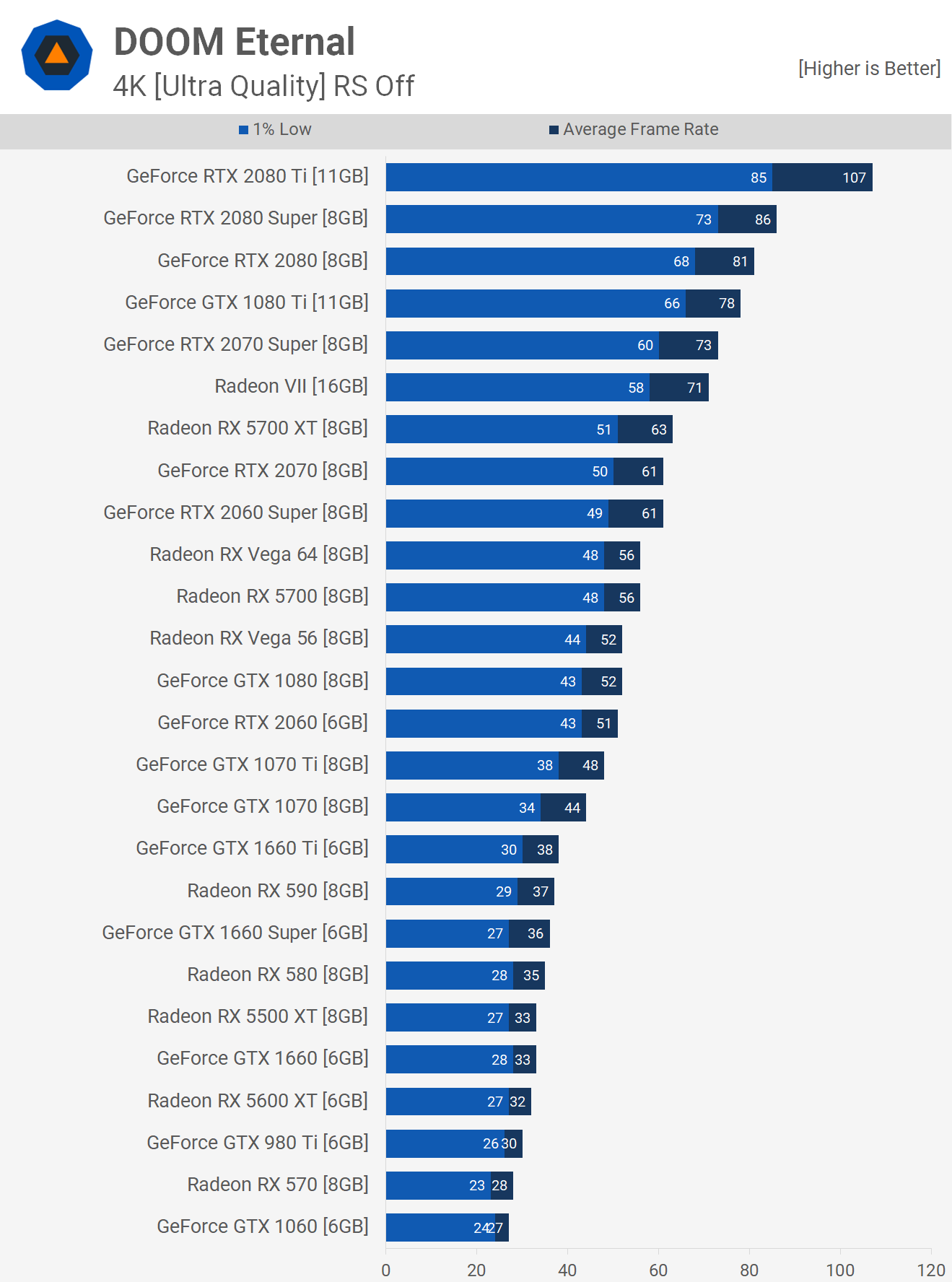
When it comes to preset scaling we see once again that the Ultra, Nightmare and Ultra Nightmare settings are all very similar in terms of performance, as long as you have 8GB or more VRAM available. For a performance boost you'll need to drop down to Medium, this resulted in an 8 to 10% increase in frame rate, while Low provided a further 5 to 6% boost.
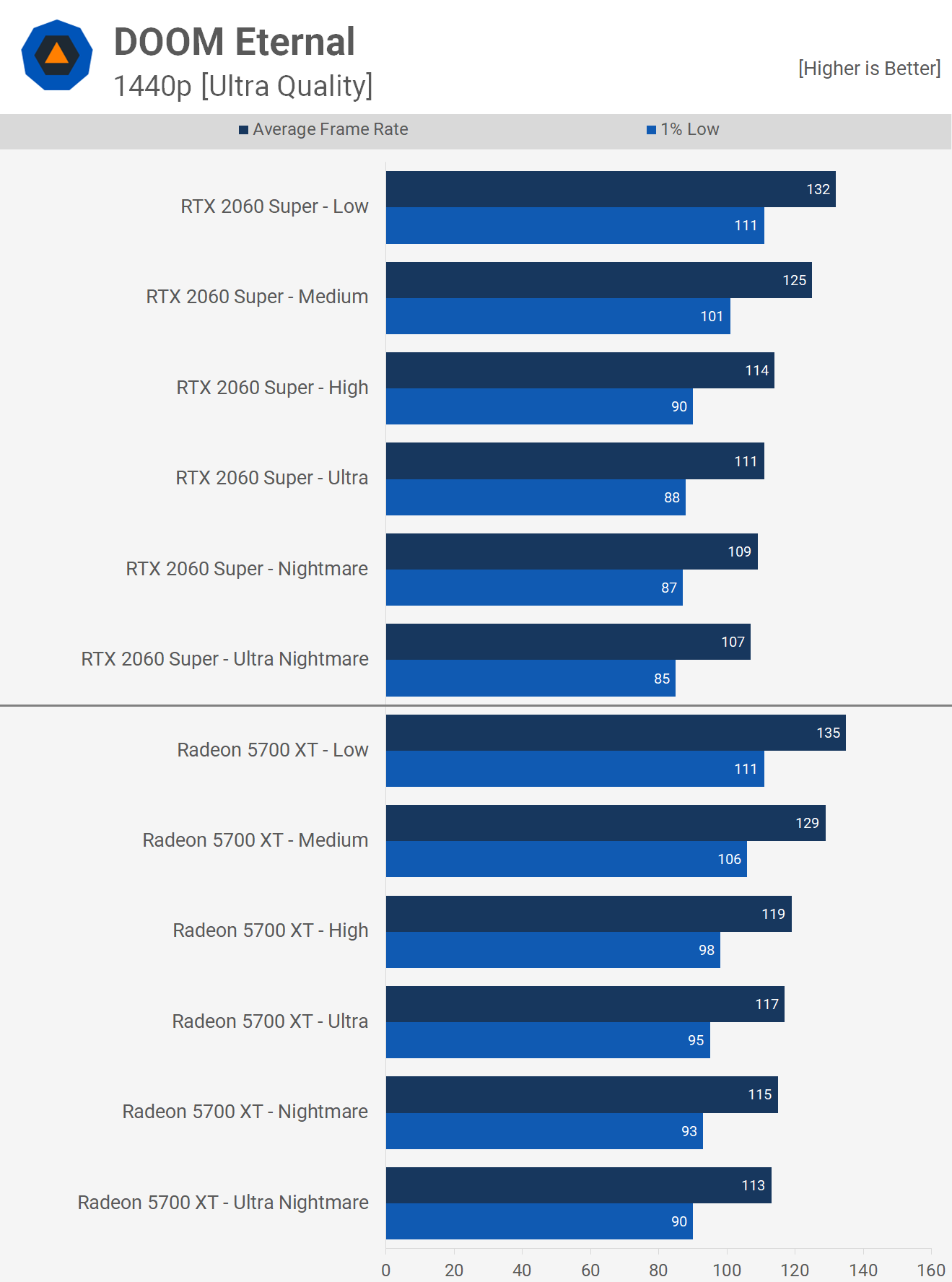
Dynamic resolution scaling seems to work very well in Doom Eternal. We don't plan to analyze image quality, but for the most part it's very difficult to spot the differences, so this setting is worth having on if you're in need of some extra frames.
At 4K and a 60 fps target boosted the RTX 2060 by 14% and a massive 94% for the 5600 XT as the lower resolution alleviates the VRAM bottleneck. The Radeon 5700 saw a milder 11% performance increase. Then we see the 120 fps target boosted the 5700 by a massive 45%, 23% for the 5600 XT, and 38% for the RTX 2060.
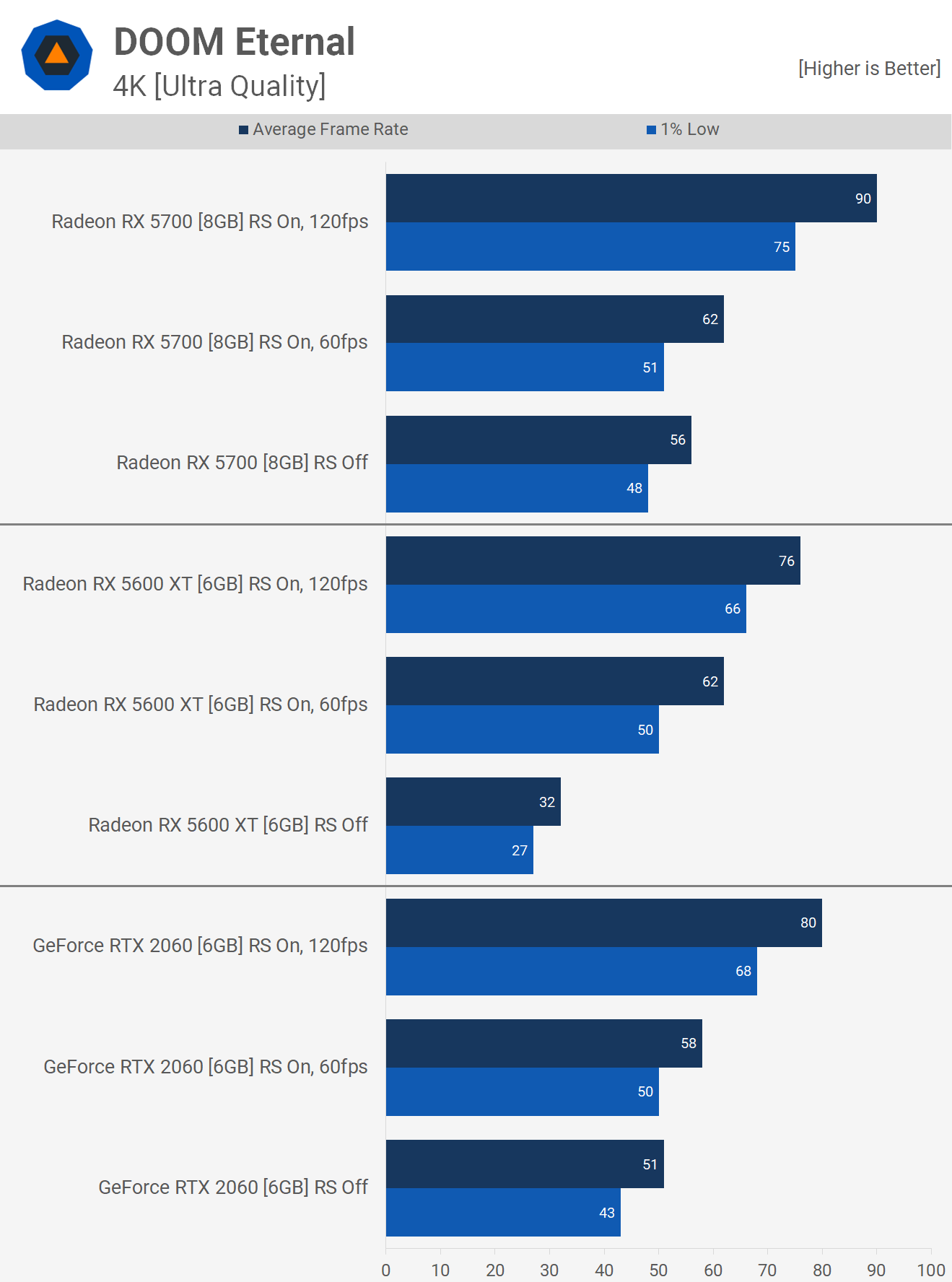
Smooth Gameplay
That's how the current generation of GPUs perform in Doom Eternal, at least those with 6GB of VRAM or more. For parts such as the 4GB 5500 XT or GTX 1650 series, we'll have to test later to see how they perform along with a wide range of older GPUs.
Those of you gaming with a GTX 1060, or something of equivalent performance, the point of this test is to give you an idea of what you will need to upgrade to, in order to boost your performance by the desired amount, whether that boost is 30%, 40% or more.
For example, at 1440p the GTX 1060 averaged 50 fps with the ultra preset, a 65% boost can be had with the GTX 1660 Super, pushing over 70 fps in our test. So, for around $230 that's a good way to get strong 1440p performance. There's also dynamic resolution scaling which can boost performance dramatically, but how much this impacts visual quality, or at least how noticeably, will be an article for another day.
Both AMD and Nvidia hardware performs exceptionally well in this title. As long as you have enough VRAM, you're good to go. In some preliminary testing we have noticed however that older hardware struggles on Doom Eternal, even with the "Low" quality preset, but we plan to follow up with that testing shortly. That low preset still looks pretty good, though on the other hand, there isn't a ton of extra performance to be gained by dropping from ultra to low. When we tested this using a 5700 XT we saw a mere 21% boost, which is nothing considering we're dropping the preset down three levels.
Doom Eternal destroys 2GB graphics cards using the lowest quality settings. To cite one example, the GTX 770 isn't able to deliver playable performance at 1080p, often dipping well below 30 fps. For now you can get by using a 6GB GTX 1060 or 8GB RX 580 at 1080p using the Ultra quality settings, and of course, there's also the dynamic resolution scaling to play around with for an extra boost if needed.
